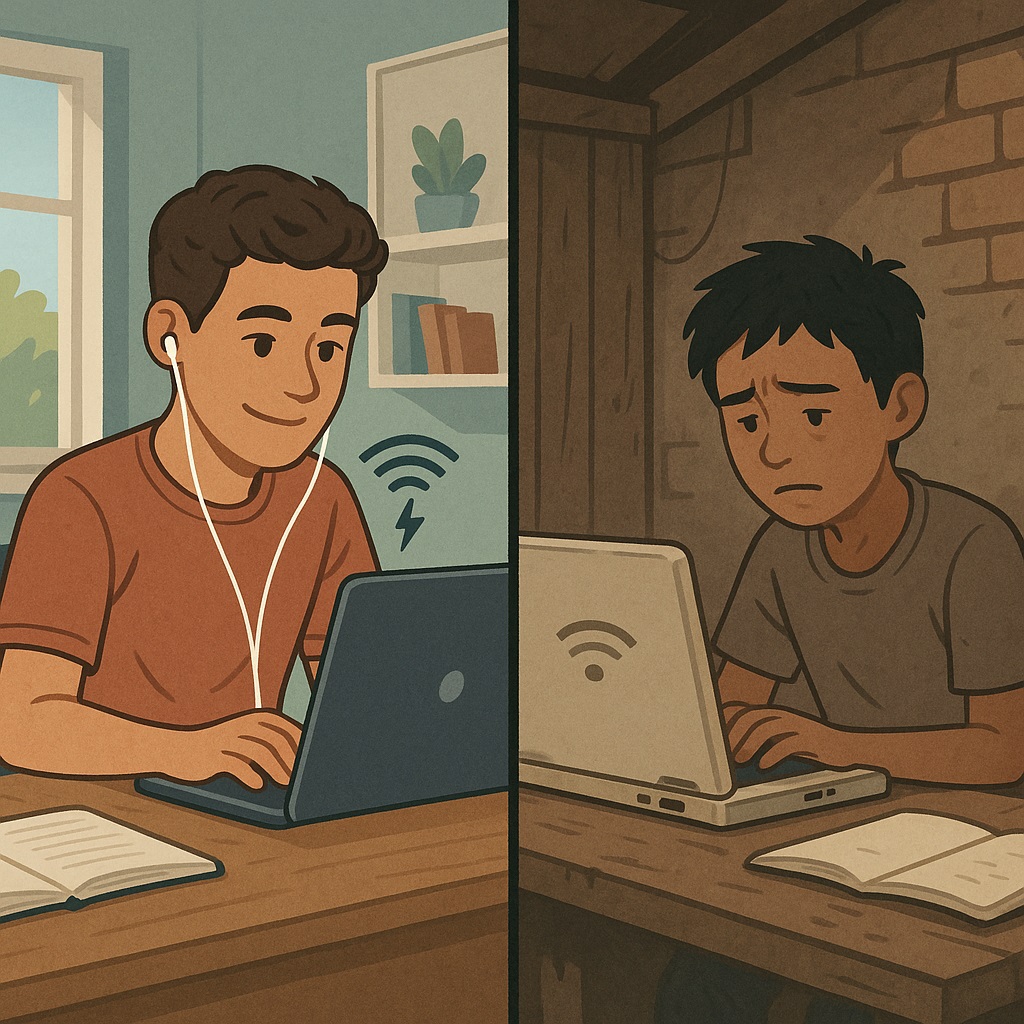
The digital divide in education means that some students have strong internet and modern devices while others do not. Today’s schools expect students to do homework online, use learning apps, and take digital tests. As a result, students without equal access quickly fall behind their peers.
When one student has high-speed Wi-Fi, a personal laptop, and access to educational apps, while another relies on a shared phone with limited data, the playing field is far from even. This gap is what educators and policymakers call the digital divide, and it determines who thrives in the modern classroom and who falls behind.
Why the Digital Divide in Education Still Matters
Lessons from the COVID-19 Pandemic
When schools moved online during COVID-19, the digital divide in education became clear. Some students joined classes without problems, while others could not attend at all because they lacked internet or devices. For example, many children sat outside restaurants just to use Wi-Fi. This showed that access to technology is no longer optional it is necessary.
The New Normal of Technology in Schools
Even though schools have reopened, digital learning is here to stay. Assignments are often submitted online, teachers use apps to track progress, and state testing increasingly relies on internet-based platforms. If students lack reliable access, they miss out on critical skills such as digital literacy, research techniques, and collaboration through online tools skills that employers now consider basic.
Who Gets Left Behind in the Digital Divide in Education?
Rural vs. Urban Students
Students in rural areas often face poor or no broadband coverage. Although government programs try to expand internet service, many families still cannot connect to reliable networks. Therefore, rural students remain at a disadvantage compared to urban peers who enjoy faster internet and more digital tools.
Low-Income vs. Wealthier Families
Technology access is deeply tied to family income. Wealthier households can afford personal laptops, tablets, and monthly broadband subscriptions. Low-income families often rely on outdated devices, shared computers, or phones with prepaid data plans. For students, this can mean being unable to complete digital assignments on time, attend virtual tutoring, or participate in group projects.
Schools with Unequal Resources
Public schools in wealthier districts often receive more funding for technology infrastructure. They may offer 1-to-1 laptop programs, digital textbooks, and well-trained tech staff. Underfunded schools, however, may struggle to provide even basic computer labs. This inequality reflects broader systemic challenges in education funding.
Solutions to Close the Digital Divide in Education
Expanding Internet Access
Affordable and reliable broadband should be treated as a basic service, not a luxury. In addition, public and private programs can expand internet coverage in rural areas and lower costs for low-income families. This way, the digital divide in education can start to close.
School-Supplied Devices
One of the most effective strategies is school-issued laptops or tablets. By ensuring every student has access to a personal device, districts can help level the playing field. Device loan programs, combined with affordable repair plans, keep technology in students’ hands year after year.
Teacher Training and Digital Equity Awareness
Technology alone is not the solution. Teachers need professional development to understand digital equity. Training helps them adapt lessons for students with limited access, ensuring no child is left behind because of technical barriers.
Community Solutions
Libraries, community centers, and local nonprofits can also play a role. Offering free Wi-Fi, homework hotspots, and after-school computer labs provides students with additional opportunities to stay connected.
Why Closing the Digital Divide in Education Matters for Public Schools
The digital divide in education is about more than just devices. It shapes whether students can compete in school, graduate ready for work, and succeed in college. Without equal access, the gap between wealthy and low-income students grows wider, putting whole communities at risk of falling behind in today’s digital world.
Bridging this divide is about fairness, opportunity, and preparing every student for a future where technology will define success.
Related Learning:
- Politics of Education K-12 by Lonnie Palmer – a deeper dive into the challenges and policy debates in public education.
- Visit the Lonnie Palmer Blog – explore more articles on education reform, equity, and public school challenges.
- FCC Affordable Connectivity Program – government program helping families access affordable internet service.
- Pew Research: Digital Divide Persists – data-driven insights into technology access gaps across the US.
FAQs
Q1. What does digital divide in education mean?
It means some students have full access to technology and internet for learning, while others do not. This gap directly affects how much students can achieve in school.
Q2. How did the COVID-19 pandemic affect the digital divide in education?
During remote learning, students without devices or reliable internet could not attend classes or complete work. It revealed how critical digital access is in modern education.
Q3. Who is most impacted by the digital divide in education?
Low-income families, rural communities, and students in underfunded schools are most likely to be affected. They often lack reliable internet, personal laptops, or school resources.
Q4. What are solutions to close the digital divide in education?
Affordable broadband, school-issued devices, teacher training, and community Wi-Fi hubs are key steps toward closing the gap.
Q5. Why is solving the digital divide in education important?
Because technology is part of everyday learning. Without equal access, students fall behind in academics, digital skills, and job readiness.